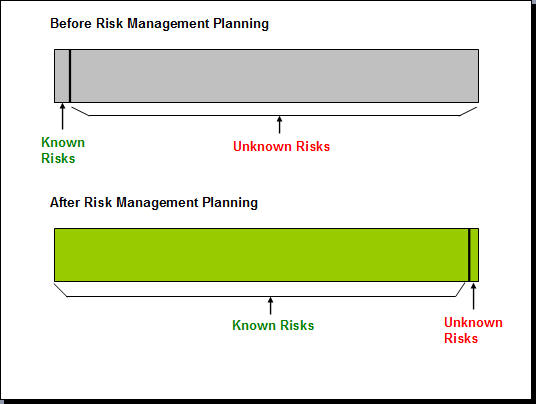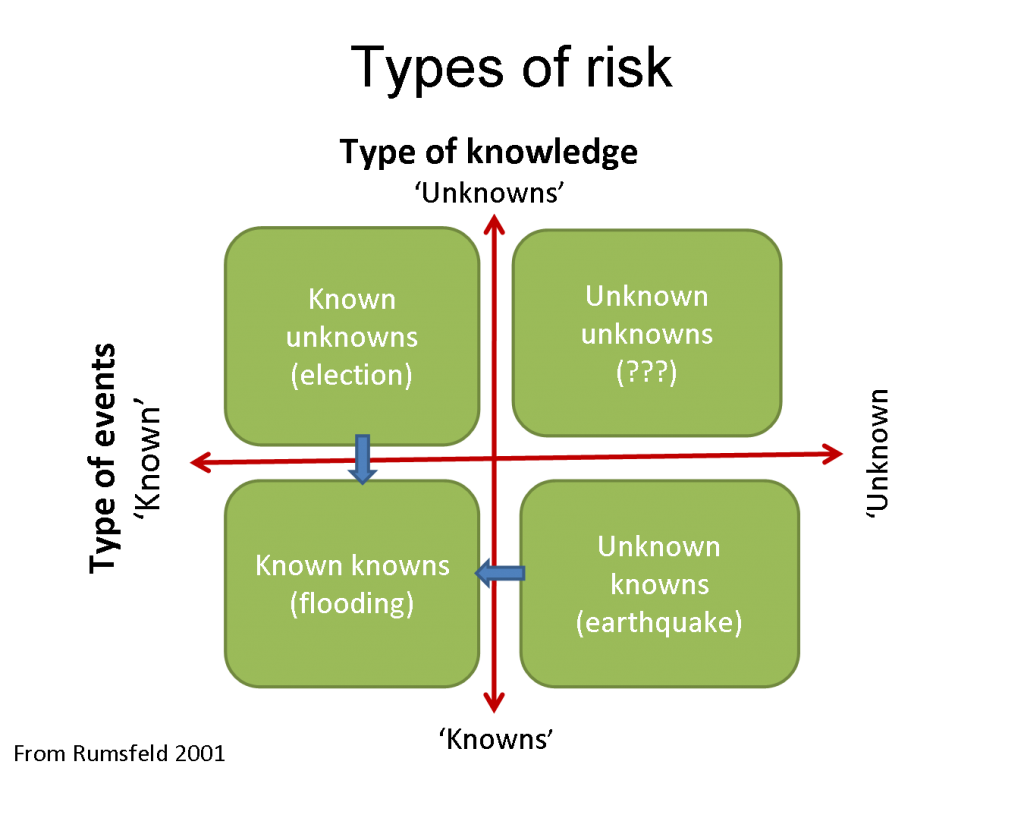Known Risks and Unknown Risk
The risk is future uncertain event or condition that, if it occurs, has a positive or negative effect on one or more project objectives. [PMBOK6]
The risk is the effect of uncertainty on objectives, and an effect is a positive or negative deviation from what is expected. [ISO31000]
Project risk whether known risks and unknown risks both are an undefined event or condition, if it occurs, has an influence on one or more of the project objectives. Risk management emphasizes on determining and evaluating the risks of the project and managing those risks to curtail the effect. The purpose of measuring risk is to find out what would be the most likely maximum impact on the project objectives. There are hardly any risk-free projects since there are multiple events that can negatively influence the project. Risk management is not simply about minimizing risk but at the same time identifying, analyzing and managing risk.
Risk management focuses on identifying and assessing the risks to the project and managing those risks to minimize the impact on the project. Risk management is simply what you do to prepare for the unexpected. No matter where you are on this continuum, risk management is a part of your daily life if you wear your seatbelt, lock your doors, use passwords or do other everyday tasks. You don’t know if you any of these events are going to occur but you are prepared. The same principle applies to your association.
Known Risk
A known risk means that the project manager thoroughly comprehends the consequences that could result in a challenge to overcome. For instance, while setting a budget, there is a known risk that project may surpass the economic estimates and for that reason, the project may encounter issues in meeting the completion deadline. The known risks are identified and evaluated for which further planning is possible. While other risks are unpredicted. Also, to manage known risks, you will primarily need to use the contingency reserve.
there are two types here
- Known Known : Risk is known and its effects are largely known. There might be variances in the losses, but shouldn’t be beyond the acceptable limit.
- Known Unknown : Risks are known and expectations to be them true is also hight but the impact is not properly measured or fully understood.
Example:
You are informed about that one of your team members may require a leave during the peak time of a project. Since you already know about the risk, you will perhaps make an arrangement and compensate the work on his/her behalf.
Unknown Risk
Unknown risks are more threatening since they can come up when the project manager doesn’t expect it. Unknown risks are unidentified because they are not known until they happen. It’s nearly impossible to formulate a response plan for these risks. You are unable to manage these risks proactively since they are not determined during the planning phase. Unknown risks are primarily managed through the workaround. To effectively manage these risks, you will need to use the management reserve. However, keep in mind that there is a difference between the contingency and management reserve. As a project manager, you are permitted to use the contingency reserve, though to use the management reserve you will need management approval. These results are unpredictable and so the consequences of such misfortune may have negative implications on the project.
Examples:
Weather: Suppose project team members were flying for a project evaluation in South Carolina when all flights are suddenly cancelled due to a serious storm. Consequently, the project team couldn’t make a meeting and unable to return home for a few days.
Sudden Family Death: Prior to a project meeting, the instructional design lead gets the unfortunate news of his father’s death. As a result, there will be a delay in making decisions on crucial events without the knowledge and evaluation of the instructional designer.
These events are unanticipated by the project team and in both cases, the project will experience the delayed schedule and additional costs.
Differences between known risks and unknown risk
To differentiate between the known and unknown risks, the project managers are encouraged to prioritize the project objectives. Known risks can be identified, analyzed & planned in advance whereas unknown risks are unable to anticipate and describe.
One effective way is to list down all the known risks associated with the project and brainstorming about all other possible risks that may occur. Also, it includes a solutions list which serves as an important backup plan to deal with these unexpected financial losses, project team challenges, and resource distribution shortages.

General Discussion on Knowledge Quandrant
A typical classification of risks is based on the level of knowledge about a risk event’s occurrence(either known or unknown) and the level of knowledge about its impact (either known or unknown). This leads to four possibilities (Cleden, 2009):
- Known–knowns (knowledge),
- Unknown–knowns (impact is unknown but existence is known, i.e., untapped knowledge),
- Known–unknowns (risks), and
- Unknown–unknowns (unfathomable uncertainty).

Project managers try to maximize known knowns by detecting as many unknown knowns as possible, as early as possible. However, it is impossible to identify all risks in advance for many reasons (Hillson, 2005), and unidentified risks remain as unknown unknowns until they are identified or actually happen.
Further Readings
- Known or Unknown – what type is your risks are?
- Kim, S. D. (2012). Characterizing unknown unknowns. Paper presented at PMI® Global Congress 2012
- DEFINING RISK
- Knowns and Unknowns – The Core of Risk Management


One thought to “Known Risks and Unknown Risks – PMP/CAPM”
Pingback: Mitigation plan, Fallback Plan, Contingency Plan and Workaround - PMP/CAPM - Mudassir